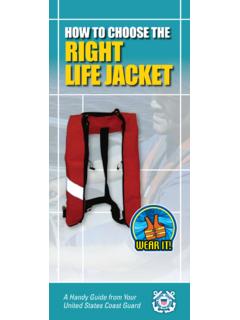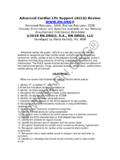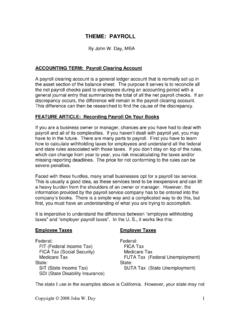Transcription of SAFETY EQUIPMENT Safety Equipment - Connecticut
1 SAFETY EQUIPMENT . SAFETY EQUIPMENT A. s boat operator, your fun on-the water depends on your Be worn by anyone being pulled behind a boat (such as tubing behavior. It is your responsibility to have the SAFETY equip - or skiing). ment required by law, to keep it on board in good condition, Be worn by anyone in a manually propelled vessel from PHOTO CREDIT - BOB DANEK. and know how to properly use it. YOU ARE IN COMMAND! October 1 through May 31 (must be Type I, II, II, V or V-hybrid). Connecticut Life Jacket and Remember: Personal Flotation Device (PFD) Laws Ski belts are not legal life jackets.
2 More than 90% of the drowning related boating fatalities may Inflatable life jackets may not be used by persons engaged in have been avoided by wearing a life jacket. high-speed water sports (such as riding PWCs or waterskiing) and There must be a wearable life jacket on board for each person may not be used by persons weighing under 90 lbs. or under 16. aboard every vessel. years of age. Each life jacket must be readily accessible. All vessels 16 feet and over, except kayaks and canoes, must Each life jacket must fit the intended wearer. also carry a Type IV throwable device in addition to the required If the vessel is required to have a Type IV throwable PFD (see number of wearable life jackets.)
3 Page 30), it must be immediately available. Sound Producing Device - Whistle (Horn) and Bell Navigation rules (part of Federal Law) require all vessels Life jackets must: (including manually propelled vessels) to have audible signaling Be Coast Guard approved. devices. (See table on page 30.). Have a legible label. Every vessel of 12 meters ( ft.) or less in length must Be of the correct size and fit for the wearer. A life jacket should have some means of making an efficient sound signal. fit comfortably snug and never cover your face or ride up past your ears. Fire Extinguishers Be in serviceable condition (all straps and buckles must be in Fires involving burning wood, fabrics and paper (Type A) can good condition and able to perform their jobs; all seams and material be put out with water.
4 Must be intact). Most boat fires consist of burning flammable liquids such as oil Be worn by children under 13 years old on any vessel that is or gasoline (Type B). Check the table at the beginning of this section underway unless the child is below deck or in an enclosed cabin. to determine how many Type B-1 fire extinguishers you must Be worn by anyone operating or riding on a PWC. have on your boat. Electrical fires can be put out with a Type C extin- 28 2018 Connecticut BOATERS GUIDE. SAFETY EQUIPMENT . guisher. propulsion machinery; and Check frequently to be sure that fire extinguishers are properly Manually propelled vessels.
5 Mounted where they can be easily reached. Check pressure gauges for proper pressure. Shake dry chemical units to be sure the chemical All other vessels need to carry three daytime and three nighttime has not solidified and become useless. Replace any questionable VDS (or the equivalent) at all times while on FIS and LIS. extinguishers. Visual distress signals must be Coast Guard approved, in Important Note: Late in 2017, The Consumer Product SAFETY serviceable condition and stowed to be readily accessible. Commission published an important recall notice; Kidde Recalls Fire Coast Guard approved pyrotechnic visual distress signals Extinguishers with Plastic Handles Due to Failure to Discharge and and associated devices include: Nozzle Detachment: One Death Reported (Recall number: 18-022) All Pyrotechnic red flares, hand-held or aerial.
6 Affected fire extinguishers should be replaced. For more information Pyrotechnic orange smoke, hand-held or floating (day use about this recall go to and look under Support / only). Product SAFETY Notices. Launchers for aerial red meteors or parachute flares. If VDS are required there must be a minimum of three daytime Ventilation and three nighttime signals, or three combination day/night signals. Regulations require ventilation of all enclosed engine and fuel Pyrotechnic devices will have an expiration date that must not have tank compartments on gasoline-powered boats. Intake ducting must passed.
7 Extend midway to the bilge or at least below the carburetor air intake Non-pyrotechnic visual distress signaling devices include: level. Exhaust ducting must extend from the lower bilge to cowls in Orange distress flags. the open air. Electric distress signals. Manufacturers install exhaust blowers in engine compartments so Other VDS, such as those listed below, are useful and easy to that gasoline fumes can be removed before the engines are started. If carry and are recognized as distress signals, but do not count toward your boat is installed with an exhaust blower, it is recommended that the requirement to carry approved VDS on LIS and FIS.
8 You turn it on for at least four minutes before starting the engine. Signaling mirror. Water dye. Visual Distress Signals (VDS) No person, operator or owner in a vessel shall display or allow Visual distress signals are used to summon assistance when in the display of a visual distress signal except when assistance is distress. Beware that the Coast Guard has recognized techno- needed because of immediate or potential danger to the vessel or to logical advances in VDS and has approved some electronic signaling persons aboard. devices. These devices when used properly are acceptable substitu- tions for traditional pyrotechnical signaling devices (flares).
9 Disposal of Expired Pyrotechnical As with any piece of SAFETY EQUIPMENT , there are advantages and Visual Distress Signals (VDS) (Marine Flares). disadvantages to different styles of VDS. Neither traditional nor mod- Because of their chemical make-up and flammable characteris- ern VDS are perfect for every situation. Boaters must decide which tics, the disposal of expired pyrotechnical VDS is strictly regulated by VDS offer them the most benefits depending on the type and location the US EPA and US DOT. The Boating Division is NO LONGER able to of boating they do. When choosing a VDS careful consideration collect expired VDS but does arrange a limited number of disposal should be given to: opportunities each year.
10 --Reliability; We encourage you to take advantage of our Flare Day Events, --Ease of disposability of expired VDS; which allow you the opportunity to dispose of expired VDS and to --Intended waterbody; learn the proper way to use VDS before you need them in an emer- --Visibility in areas of dense background lights; gency situation. --Dangers of burning a VDS; For information about the disposal of VDS or Flare Day Events, see --Length of useful signaling run time;. --Portability can the VDS be carried safely and effectively by a person. NOTE: Exceeding noise levels is a serious problem.

















